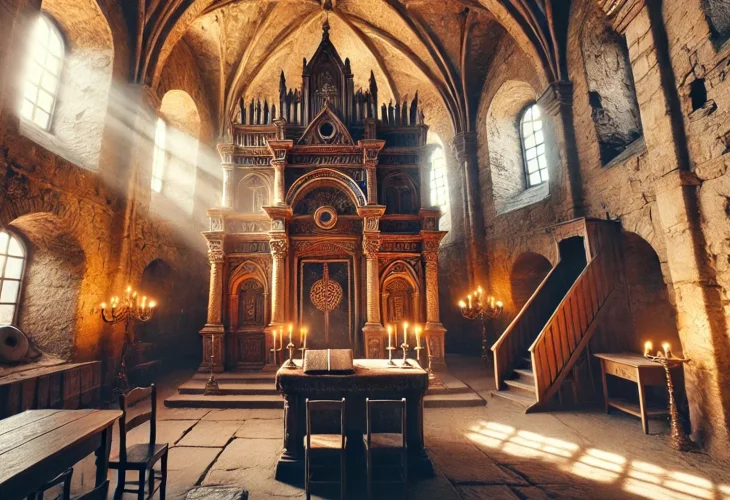History and Archaeology
A Tale of Resilience: The Synagogue’s Battle for Survival
In 1792, the community was miraculously saved when a Russian attack on the synagogue—mistakenly believed to be a fortress—ended with an intact cannonball breaching its walls without exploding.

The town of Ostroh, in present-day Ukraine, has witnessed centuries of struggle and upheaval. Though modest in size today, with a population of about 13,000, Ostroh possesses a remarkably rich history. Around a thousand years ago, it formed part of the Kievan Rus’ principality and subsequently changed hands numerous times through war. It was ruled alternately by Lithuania and Poland. In the seventeenth century, it came under the control of the noble Ostrogski family until their lineage ended amid conflict, after which authority passed to the Lubomirski family. Over time, Ostroh shifted repeatedly between Polish, Russian, and Ukrainian rule, eventually becoming part of modern Ukraine.
Jews lived in Ostroh for centuries, and by the outbreak of World War II the town had become predominantly Jewish. As in many parts of Europe, these rights were hard-won and often paid for in blood. In 1495, the Jews were expelled from Ostroh, only to return eight years later. The arrival of Rabbi Shmuel ben Eliezer—known as the Maharsha—transformed the town into a major center of Polish Jewry. Ostroh later became home to other towering rabbinic figures, including Rabbi Isaiah Horowitz, the Shelah HaKadosh; Rabbi David Halevi, author of the Taz; and Rabbi Solomon Luria, known as the Maharshal, among many others. With the rise of the Hasidic movement, prominent figures such as Rabbi Meir Margolis, a disciple of the Baal Shem Tov, and Rabbi Nathan of Breslov also settled there. Jewish printing presses flourished in the city, playfully signing their works “Ost Torah” instead of Ostroh—an apt reflection of the town’s scholarly spirit.
At the heart of the Jewish quarter stood an ancient synagogue, approximately eight hundred years old. Records of its original construction were lost in one of the city’s many fires, leaving its beginnings shrouded in mystery. In the early seventeenth century, Rabbi Shmuel ben Eliezer, the Maharsha, revitalized the synagogue by establishing a great yeshiva, funded by his mother-in-law, Rebbetzin Edel, the widow of Rabbi Moses of Brisk. In her honor, he adopted the name Rabbi Shmuel Eidels, immortalizing her legacy. Under his leadership, the synagogue was renovated and expanded, becoming one of the most magnificent in the region. The Maharsha’s study room still stands today.
The Maharsha’s commentary is renowned for its meticulous analysis of the Talmud and its interwoven themes. His writings span the entire Talmud and are traditionally divided into two sections—one addressing legal innovations and the other focusing on narrative and ethical insights. His yeshiva offered comprehensive study of the entire Talmud, a rarity for its time.
The Maharsha’s devotion to Torah study was legendary. According to tradition, he allowed his hair to grow long and tied it to a hook in the ceiling, ensuring that if he nodded off while learning, the painful tug would awaken him and force him back to his studies. Under his leadership, Ostroh became a center for the Council of the Four Lands, the primary governing body of Polish Jewry, with the Maharsha serving as its leading rabbinic authority. The council convened annually in Lublin and later in Danzig, drawing merchants and rabbis from across Europe for legal proceedings and communal decrees. In his writings, the Maharsha occasionally notes, “Between here and such-and-such a page I wrote nothing, as I was at the Lublin fair.” Above the entrance to his home hung the inscription, “My door is open to guests,” reflecting his lifelong commitment to hospitality, charity, and kindness alongside Torah scholarship.
On the day after Passover in 1768, during the Haidamak uprising, the Jews of Ostroh hired Tatar mercenaries to defend the town against surrounding peasants intent on massacre. In 1792, the community again faced mortal danger when Russian soldiers mistakenly attacked the synagogue, believing it to be a fortified stronghold. Miraculously, a cannonball struck the synagogue wall without exploding. A courageous young man named Eliezer then approached the Russian forces and managed to avert further destruction. In commemoration of this miracle, the unexploded shell was hung by a chain on the synagogue’s southern wall and became known as the “miracle shell.” Today, it can be seen in the Ostroh city museum. Since that event, the seventh day of Tammuz has been celebrated by the community as Ostroh Purim.
In 1931, marking the three-hundredth anniversary of the Maharsha’s passing, the Chofetz Chaim sent a student to reopen a yeshiva in the Maharsha’s synagogue after decades of inactivity. The yeshiva attracted 140 students—a remarkable number for the period. With the outbreak of the Holocaust, however, the students fled, and tragically, most did not survive. After the war, the communist authorities converted the synagogue into a medical warehouse.
In 2015, the synagogue’s roof began to collapse. Following a determined public campaign, Grigory Hershinov—a Jewish member of the Ostroh city council—together with Rabbi Hillel Cohen and Mr. Anatoly Sheingate, launched a project to rescue and restore the historic building. Hundreds of archival documents detailing the synagogue’s storied past and its renovation by the Maharsha were collected, along with rare historical photographs that even depicted the miracle shell. By the month of Elul in 2019, the synagogue was once again opened for prayer.
Today, visitors to Ostroh can join a minyan in one of Europe’s oldest and most magnificent synagogues, standing in the very room where the Maharsha composed his celebrated commentary—a living testament to Jewish resilience and continuity.

